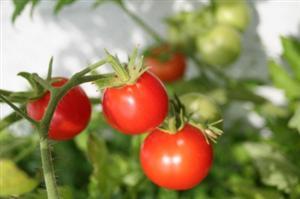| Complexity level: | 7 |
| Project cost ($): | 30 |
| Time required: | 1 hour to prepare, 10 days for observation |
| Material availability: | Easily found. May be purchased at a plant nursery. |
| Safety concerns: | None |
Hypothesis
Some plants will interact well with one another and increase in their rate of growth whereas other plants may not get along well together and growth will be delayed.
Overview
Companion Planting
Companion planting is the process of planting different types of plants together so that they will help each other to produce better crops. Each plant will have its own characteristics in attracting or repelling certain insects or having certain chemical substances in their roots.
If the relationship between the 2 types of plants is beneficial, then the growth of the plants will be faster and it will result in better crops. However if the relationship between the plants is not beneficial, the plants may grow more slowly or may not survive at all.
Companion planting can help reduce the use of chemical pesticides to protect the plants. The odor given out by certain plants can help to repel some harmful insects whereas some other plants are able to attract beneficial insects that can help with pollination, amongst other things. As an example rose plants are typically damaged/destroyed by aphids (the greenfly), but the smell from the marigold plant deters aphids and instead attracts hoverflies which kill the aphids.
Scientific Terms
Materials
The materials required for this science fair project:
- 1 packet of tomato seeds
- 1 packet of corn seeds
- 6 onions
- 5 plastic pots
- enough soil to fill the 5 pots
- Ruler (1 meter)
Procedure
1. For this experiment, the independent variable is the type of plants planted in the pots. The dependent variable is the growth rate of the plants. This is determined by measuring the average height of the 3 plants in each group and calculating the average height. The constants (control variables) are the size of the pot, the environmental factors (such as sunlight and moisture) the amount of soil and the type of plant used.
2. 5 pots are filled with the same amount of soil. Seeds and onions are planted in each pot as described below. (More than one seed can be used in each pot in case some of the seeds do not germinate. Once they start to geminate, remove the unwanted plants from the pot)
3. The pots are labeled as pot A, pot B, pot C, pot D and pot E.
a. Pot A is planted with 3 tomato seeds
b. Pot B is planted with 3 onions
c. Pot C is planted with 3 corn seeds
d. Pot D is planted with 3 tomato seeds and 3 onions
e. Pot E is planted with 3 tomato seeds and 3 corn seeds
4. The height of the plants is measured on the 10th day and the average is calculated for each group.
Results
It is observed that tomato plants grow well with onions but not with corn. The tomato plant grew an average of 48mm by itself in pot A but was able to grow up to 65mm when planted with the onion in pot D. However the tomato planted in pot E together with the corn, was only able to grow 28mm in the 10 days. Similarly the onion only grew 18mm by itself in pot B but grew 33mm in pot D when it was planted together with the tomato plant. The corn plant grew 28mm by itself in pot C but only grew 14 mm in pot E when planted with the tomato.
Pot |
Plants |
Height of the plant measured after 2 weeks (mm) |
Average (mm) |
||
1 |
2 |
3 |
|||
A |
Pot Tomato |
48 |
42 |
54 |
48 |
B |
Onion |
15 |
21 |
18 |
18 |
C |
Corn |
24 |
32 |
28 |
28 |
D |
Tomato Onion |
62 |
68 |
65 |
65 |
32 |
38 |
29 |
33 |
||
E |
Tomato Corn |
24 |
28 |
32 |
28 |
12 |
14 |
16 |
14 |
Conclusion
The hypothesis, that some plants will interact well with one another and increase growth rate whereas other plants may not get along well together and delay growth, is proven to be true.
Companion planting on farms or in your garden is an important part of pest control management. It is a way of allowing nature to play its role in bringing balance to the ecosystem. Companion planting reduces the need to use chemical insecticides. It also has other benefits like assisting in pollination and nitrogen fixation in the soil.
Also consider
What would happen if the experiment was continued over a longer period?
The experiment can be repeated using different plants like radish, potato and peas.
References
Companion planting - http://en.wikipedia.org/wiki/Companion_planting
Companion planting - http://www.no-dig-vegetablegarden.com/companion-planting.html

